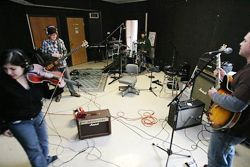Here’s a recording checklist derived from both The Recording Engineer’s Handbook and Audio Recording Basic Training that, if followed, will pretty much keep any engineer, or musician trying to record himself or his band, out of trouble.
1. Does the instrument sound great acoustically? Make sure that you start with a great acoustic sound with the instrument well-tuned and minimum of sympathetic vibrations and extraneous noises.
2. Are the mics acoustically in phase? Observe the 3:1 rule and make sure that any underneath mics are at a 90° angle to the top mics.
3. Are the mics electronically in phase? Make sure that all the mic cables are wired the same by doing a phase check.
4. Are the mics at the correct distance from the instrument? If they’re too far away they’ll pick up too much of the room or other instruments. If they’re too close the sound will be unbalanced with either too much attack or ring, and not enough of the body of the instrument.
Walk around the player, put your finger in your ear, and find the spot that sounds the best. Remember, most instruments need some space for the sound to develop. The ambience from the surrounding area is a big part of the sound for most instruments.
5. Does it sound the same in the control room as when you’re standing in front of the instrument? This is your reference point and what you should be trying to match. You can embellish the sound after you’ve achieved this.
6. Is there another problem besides the mic placement? A great sound is dependent upon the instrument, the player, the amp and the room. The player has to be able to achieve the tone you’re trying to record with his hands first and foremost. The mic itself usually has less to do with the ultimate sound than the placement, room and the player and ultimately, the project itself.
You should always trust your ears and begin by listening to the musician in your studio, find a sweet spot and then begin your microphone placement there. If you don’t like the resultant sound, then move the mic or swap it with another. EQ is the last thing you should touch.
7. Is the problem in your signal chain? Don’t neglect your microphone preamp. The better your preamp, the less trouble you’ll have capturing the sound, but sometimes a certain mic/preamp combination will give you the sound you need. Experiment.
8. Is the problem the players signal chain? A guitarist’s signal chain can be a huge help or a big hindrance. You’ll get a warmer yet aggressive guitar sound by decreasing the amount of distortion from pedals, but turning up the amp’s volume instead to obtain the sustain/distortion from the amp and speaker. Also, smaller amps and speakers tend to sound bigger than large amps/speakers when recording.
REMEMBER: Mics cannot effectively be placed by sight, which is a mistake that is all too easy to make. The best mic position can’t be predicted, it must be found.
Bobby Owsinski is an author, producer, music industry veteran and technical consultant who has written numerous books covering all aspects of audio recording. For more information be sure to check out his website and blog.





















